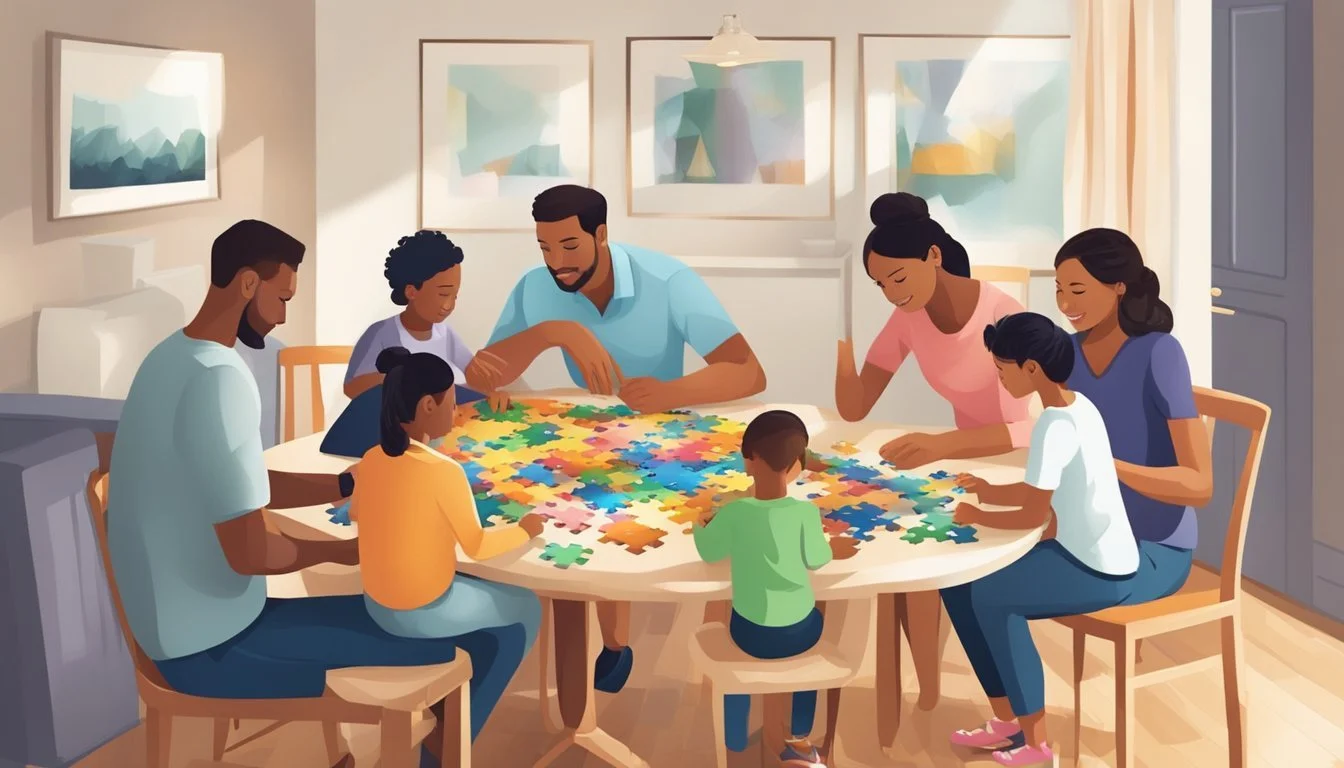13 Tips for Navigating Blended Family Dynamics
Expert Advice for Harmonious Relationships
Blending families can present unique challenges as parents and children adjust to new dynamics and relationships. The journey of creating a cohesive family unit involves understanding and patience, particularly when addressing the needs of children of different ages.
Navigating the complexities of a blended family can lead to stronger bonds and deeper connections among all family members. By implementing effective strategies and fostering open communication, families can build a supportive and loving environment that benefits everyone involved.
1) Set Clear Boundaries
Setting clear boundaries is essential for the smooth functioning of a blended family. Boundaries help prevent misunderstandings and conflicts by clearly defining expectations for behavior and responsibilities.
Establishing both physical and emotional boundaries is important. Physical boundaries might include respecting personal space and possessions within the household. Emotional boundaries involve recognizing and respecting individual feelings and limits in communication.
Openly discussing boundaries with all family members is key. This ensures that everyone understands the rules and feels comfortable expressing their needs. Rules regarding chores, screen time, and personal space should be agreed upon collectively.
Regular family meetings can be an effective way to revisit and reinforce these boundaries. These discussions should include everyone, creating a sense of ownership and respect for the established rules. Consistency in enforcing these boundaries helps maintain a harmonious environment.
Involving all adults in the household ensures a unified approach. This collaboration promotes consistency and sets a good example for the children. Having clear and consistent rules allows all family members to know what is expected, reducing stress and fostering a sense of security.
2) Communicate openly
Open communication is vital for the success of a blended family. Each member must feel comfortable expressing their thoughts and emotions.
Regular family meetings can help ensure everyone has a chance to voice their concerns. This practice promotes transparency and helps address issues before they escalate.
Using active listening techniques can enhance understanding. When listening, it is crucial to acknowledge each person's feelings without interrupting or judging.
Encourage children to share their feelings about the new family dynamics. Validate their emotions and reassurances to make them feel heard and understood.
Stepparents should also communicate openly with biological parents. This helps create a unified approach to parenting, fostering a cohesive environment for the children.
Being honest about expectations can prevent misunderstandings. Clear communication about roles, rules, and responsibilities sets the foundation for a harmonious household.
If needed, seeking guidance from a family therapist can provide valuable tools for effective communication. Professional support can help navigate more complex dynamics and ensure everyone feels supported.
Promoting open communication builds trust within the family. It lays the groundwork for a healthy and supportive relationship among all members.
3) Respect Individual Differences
Respecting individual differences is vital in blended families. Each family member brings unique backgrounds, experiences, and traditions. Acknowledging and valuing these differences fosters a sense of belonging and acceptance.
Children especially need to feel their identities are respected. Allowing them to share customs and participate in new family traditions can create a harmonious environment.
Encourage open dialogue about preferences and boundaries. Understanding different perspectives helps build mutual respect and avoids conflicts. Engaging in this practice reinforces trust among family members.
It's also important for stepparents to recognize that instant bonds may not form. Building relationships takes time and patience. Natural connections evolve gradually, provided there's consistent respect and consideration.
Celebrating diversity within the family can also create unity. Organize activities that highlight various cultural or personal interests to connect different family traditions. This approach can reinforce the idea that diversity is a valuable strength.
Finally, respecting individual differences includes personal space and time. Each member may occasionally need alone time or personal space. Acknowledging this need contributes significantly to overall family harmony.
More strategies for navigating blended family dynamics can be found on Verywell Mind. Explore tips on fostering love and connection by encouraging open communication and creating a safe space for everyone to share their thoughts and feelings.
4) Create Inclusive Family Rituals
Incorporating inclusive family rituals helps blended families bond and create a sense of unity. Activities like weekend breakfasts, game nights, or movie marathons can become traditions everyone looks forward to. These activities provide a regular opportunity for family members to connect and enjoy each other's company.
It's important to consider the backgrounds of all members. New traditions that everyone can participate in will create a sense of belonging and mutual respect. This could include celebrating holidays in ways that incorporate customs from each side of the family.
Another effective strategy is to involve everyone in brainstorming new rituals. This approach ensures that each person's ideas are valued and incorporated, fostering a more cohesive family unit. It can be as simple as a monthly picnic or a yearly vacation.
Regular family meetings can also serve as a ritual where everyone can discuss their feelings and plans. These meetings help in maintaining open communication and ensuring that everyone feels heard and included.
Encouraging participation in creating these rituals strengthens the relationships within a blended family. Simple acts like shared cooking sessions or themed activities can leave a lasting impact on the family dynamic.
5) Seek Professional Support
Blended families can face unique challenges that may benefit from the guidance of a professional. Seeking help from a family therapist or counselor can provide strategies to address specific issues within the family.
Professional support can assist in navigating conflicts and improving communication among family members. They can offer tools to manage relationships and integrate new family dynamics smoothly.
Counselors specializing in blended families bring a wealth of experience and understanding of the intricate dynamics involved. Their tailored approaches can address the needs of children and adults alike, ensuring that each member feels heard and supported.
Utilizing professional support can be particularly useful during high-stress periods, such as holidays or significant life changes. Expert advice can help maintain a stable and positive family environment during these times.
6) Practice patience and empathy
Patience and empathy play a crucial role in blended family dynamics. Family members may have different needs and emotional experiences. It is important to approach each situation with understanding and compassion.
Children in blended families often need time to adjust. Toddlers, for example, benefit from simple and reassuring language about changes in their environment. This can create a sense of security.
Adolescents face unique psychological and emotional challenges. They require a compassionate approach and validation of their feelings. Open communication allows teenagers to express their concerns and feel heard.
Each family member’s journey is different. By practicing active listening, parents can show that they value and respect individual experiences. This fosters a stronger sense of belonging and connection.
Empathy involves recognizing and validating the emotions of others. When blended families come together, conflicts can arise. Addressing these with empathy helps to resolve issues more effectively.
Patience is equally important. Integrating into a new family structure takes time. Allowing the process to unfold naturally and giving space for relationships to develop can ease tension and build trust within the family unit.
Creating an environment where empathy and patience are practiced daily contributes significantly to the overall well-being of the blended family.
7) Prioritize Couple Time
Maintaining the strength of the marital relationship is critical in a blended family. Couples need to carve out regular time for each other, away from parenting and household responsibilities.
Spending quality time helps reinforce the bond. This can involve date nights, shared hobbies, or simply enjoying a quiet evening together at home.
Communication during couple time is essential. Discussing challenges, joys, and plans helps both partners stay aligned and supportive of one another.
It also sets a positive example for the children. Observing a healthy, loving relationship between parents can contribute to a more harmonious home environment.
Using established routines for couple time can provide consistency and reliability. Regularly scheduled time together can become a cherished tradition within the family.
By prioritizing their relationship, couples can better manage the complexities of blended family dynamics. The investment in couple time ensures the marital foundation remains strong and resilient.
8) Encourage one-on-one bonding
One effective way to strengthen blended family relationships is through one-on-one bonding. Parents and stepparents should spend individual time with each child to foster a unique connection. These moments don't need to be elaborate; they can be as simple as a walk in the park or a shared hobby.
Children often feel more comfortable expressing their thoughts and feelings in a one-on-one setting. This dedicated time lets parents understand each child's unique personality and needs. It helps build trust and encourages open communication.
Planning regular one-on-one activities can also help reduce feelings of competition among siblings. Each child gets the attention and validation they need, contributing to a more harmonious family environment. It's essential to be consistent with these activities to show commitment and genuine interest in the child's life.
For more detailed strategies on fostering connections in blended families, refer to tips from HelpGuide and Blended Family Matters. One-on-one bonding is not only beneficial but essential for the healthy development of relationships within a blended family.
9) Reframe Negative Situations
Negative situations in blended families can be opportunities for growth. Challenges like conflicts between stepparents and biological parents or differing parenting styles are common. Recognizing these issues as chances to develop problem-solving skills can foster a positive environment.
Encourage family members to express their feelings openly. This practice allows everyone to understand each other's perspectives and reduces misunderstandings. Open communication can turn potential conflicts into constructive discussions.
Implementing family therapy can be beneficial. Professional guidance can help reframe issues and provide strategies to manage them effectively. This approach creates a supportive atmosphere where all members can thrive.
Emphasize the strengths that each member brings to the family. Valuing diverse experiences and viewpoints helps in building a cohesive unit. This positive focus can shift the narrative from conflict to collaboration.
10) Maintain Consistency in Rules
Consistency in rules is crucial for blended families. Maintaining the same rules across all households helps children feel more secure and reduces confusion. When parents and stepparents uphold the same guidelines, it provides a unified front.
Children thrive in environments where they know what to expect. Clear, consistent rules help them understand boundaries and consequences. This predictability assists in adjusting to new family dynamics.
Different parenting styles can complicate rule consistency. Open communication between parents and stepparents about discipline and expectations is essential. Agreeing on core rules and adhering to them fosters a stable environment.
Implementing routine schedules, such as consistent bedtimes and homework rules, helps maintain stability. Children benefit from knowing that expectations don’t vary drastically between households. This sameness aids emotional adjustment.
When conflicts arise, it is vital to revisit and reinforce agreed-upon rules. Regular family meetings can help in discussing and adjusting house rules, ensuring everyone’s on the same page. This process involves both adults and children, promoting a collaborative atmosphere.
11) Support biological parent-child relationships
Supporting the bond between biological parents and their children is critical in blended families. These relationships form the foundation of emotional stability for the children involved.
Encourage one-on-one time between the biological parent and their child. This individual attention helps maintain trust and familiarity, which is essential for the child's sense of security. Shared activities can strengthen their connection.
Respect the pre-existing bond. Stepparents should acknowledge and support these relationships without feeling threatened. Recognizing the importance of this bond can help children adapt more comfortably to the new family dynamic.
Clear communication is vital. Biological parents should reassure their children of their unwavering love and commitment. Explaining that the addition of a new family member does not diminish their relationship can alleviate anxiety.
Supporting these relationships involves understanding and patience. Allow children to express their feelings about the changes in the family. Validate their emotions and offer consistent reassurance.
Seek professional help if needed. Counseling can provide a neutral space for addressing concerns and strengthening family bonds. It can be particularly useful during the initial stages of forming a blended family.
Supporting healthy biological parent-child relationships lays the groundwork for a harmonious blended family environment. It helps children feel grounded amid the changes, encouraging a smoother transition for everyone involved.
12) Celebrate Small Victories
Recognize and cherish the moments of connection within the blended family. Celebrating small victories can boost morale and foster a sense of unity among family members. These victories might include a successful family outing, a positive conversation between step-siblings, or any instance where the family members bond.
Small celebrations can take various forms, such as a family movie night, a special dinner, or simply verbal praise. These moments help to reinforce positive behaviors and interactions. They can be a simple but effective way to show appreciation and encourage further efforts.
Encouraging children and adults alike to acknowledge these victories builds confidence and a sense of belonging. Celebrations do not need to be elaborate; the key is consistency and genuine acknowledgment. This approach helps to create a positive and supportive family environment. Appreciate the effort, not just the outcome. The path to blending a family successfully is made of these small but significant steps.
For additional strategies on promoting family harmony, you can explore more tips here.
13) Stay Adaptable and Flexible
Staying adaptable and flexible is crucial in blended families. Each member comes with their own set of experiences and expectations, which can often lead to unexpected challenges.
Parents should be open to changing routines and finding new solutions when traditional methods fail. Flexibility in scheduling and household rules can ease transitions and foster a more harmonious environment.
It's important to recognize that initial plans might need adjustments. Children’s needs and behaviors evolve, and being prepared to adapt parenting strategies accordingly can make a significant difference.
Encouraging open communication within the family can also promote flexibility. When everyone feels heard and respected, it’s easier to navigate changes together and find compromises that work for all.
Understanding Blended Family Dynamics
Blended families, formed through remarriage or cohabitation after previous relationships, come with their own set of complexities. Recognizing the unique structure and challenges can help navigate these family dynamics effectively.
Defining Blended Families
Blended families, also known as stepfamilies, consist of partners who bring children from previous relationships into a new family unit. These families can include various combinations, such as step-siblings, half-siblings, and step-parents. Each member may have different experiences and expectations, complicating interactions and relationships.
Clear communication and setting realistic expectations can help. For instance, acknowledging that it takes time for familial bonds to form ensures patience and understanding among members. Embracing the diverse backgrounds of each family member can facilitate a more cohesive and supportive environment.
Common Challenges
Blended families face several challenges, including loyalty conflicts, jealousy, and differing parenting styles. Children might struggle with accepting a new parental figure or feel torn between biological and step-parents, which can lead to emotional distress.
Addressing these issues requires open communication and empathy. Encouraging one-on-one time between members can help build trust and understanding. Professional guidance, such as family counseling, can also support families in navigating these complexities by offering tailored strategies and interventions.
Providing consistent support and fostering an inclusive atmosphere can alleviate some of the tension and help the family unit function more harmoniously.
Effective Communication Strategies
Effective communication in blended families involves establishing open dialogue and practicing active listening techniques. These skills help create a supportive and harmonious home environment.
Establishing Open Dialogue
Creating an atmosphere where family members feel safe to express their thoughts and feelings is crucial. Setting regular family meetings can provide a structured space for discussions about any issues or concerns.
Using clear and simple language ensures everyone understands the messages being conveyed. For younger children, this means using words that are age-appropriate. Encouraging honesty and transparency can also build trust among family members.
It's important to address conflicts directly rather than avoiding them. This can prevent misunderstandings from escalating. Additionally, establishing ground rules for respectful communication can help maintain a positive atmosphere during these discussions.
Active Listening Techniques
Active listening is essential in ensuring that all family members feel heard and valued. This involves giving full attention to the speaker, avoiding interruptions, and making an effort to understand their perspective.
Non-verbal cues such as nodding, maintaining eye contact, and using facial expressions can indicate engagement. Reflective listening, which involves paraphrasing what the other person said, can help clarify their message and show that their point of view is being acknowledged.
Empathy plays a critical role in active listening. By validating the speaker's feelings, family members can foster a deeper emotional connection. This helps in building a strong foundation for effective communication and mutual respect within the blended family.









